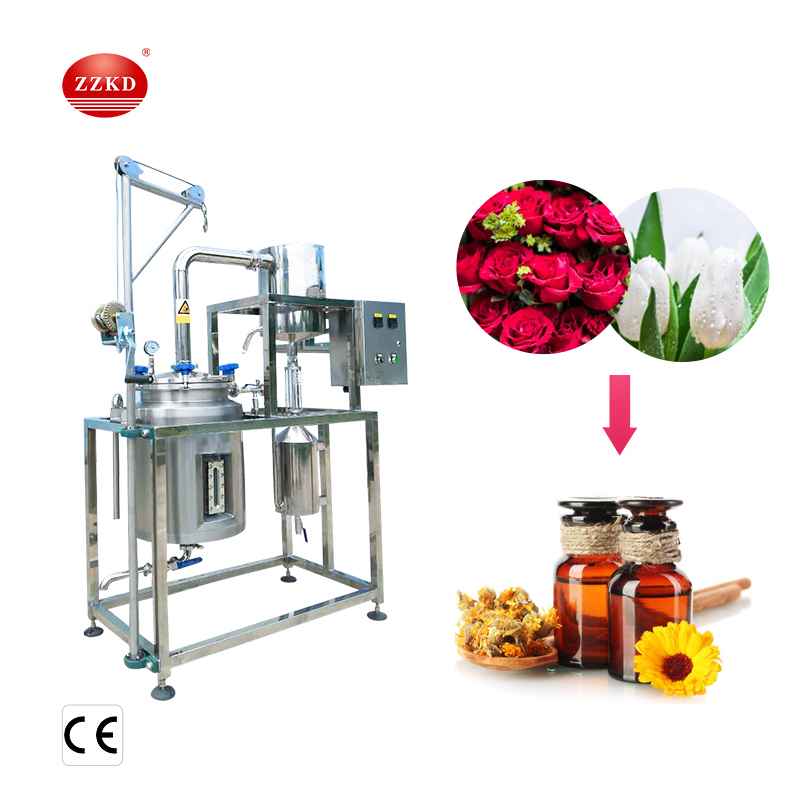Where to buy essential oil distiller
where to buy essential oil distiller? ZZKD is a professional manufacturer of essential oil extraction equipment in China. Our essential oil extraction equipment is 10L, 20L, 30L, 50L, etc. You can choose the equipment that suits you according to your needs.
Here is an introduction to the methods and characteristics of essential oil extraction:
1. Water distillation
In the production of essential oils, when using the water distillation method, the plant materials must be completely immersed in water and left to stand until the water boils. To a certain extent, this method has a protective effect on the extracted oil, because the water around the oil can be used as an obstacle to prevent the oil from overheating. When the concentrated raw material cools down, the water and the essential oil are separated. Gently move the oil into other containers and use it as essential oil. The water separated in this process is also useful and can be sold on the market as "flower water" (also known as hydrosol or sweet water), such as rose water, lavender water and citrus water. Water distillation can be carried out under reduced pressure (low vacuum) to lower the temperature and prevent it from exceeding 100°C, which is valuable for protecting plant materials and essential oils. Therefore, neroli oil, which is sensitive to heat, can be successfully extracted using this method. If some plants cannot be soaked in hot water for a long time, such as lavender, it is necessary to find a more appropriate extraction method. Any plant material with a lot of lipids is not suitable for this extraction method, because long-term immersion in hot water will destroy the lipids and newly synthesize them into alcohol and carboxylic acids.
2. Steam distillation
When steam distillation is used to extract and manufacture essential oils, plant materials are put into the distiller, and then steam is injected into the plant materials. The hot steam helps release aromatic molecules from the plant material, because the steam can force open the oil gland cells in the plant material that store essential oils. These volatile essential oil molecules are released from the plant material into the steam. The temperature of the steam needs to be carefully regulated, just to make the plant materials release essential oils. Too hot will ignite the plant materials or essential oils. The vapor containing essential oil passes through a cooling system, where the vapor is concentrated to form a liquid, so that the essential oil and water are separated from each other. The pressure of the steam used is greater than the atmospheric pressure, so the boiling temperature of the steam is above 100°C, which can promote the rapid release of essential oils from plant materials and prevent essential oils from being damaged.
3. Water vapor diffusion method
In fact, the water vapor diffusion method to extract essential oils is also a type of steam extraction method, that is, the way the steam enters the distillation tower is different. In the water diffusion distillation method, water vapor enters the plant material from top to bottom, and the water vapor in the general steam distillation method goes from bottom to top. Concentrated essential oils containing a mixture of steam and water are collected under the iron grid where plant materials are placed. The main advantages of this extraction method are the small amount of steam used, short distillation time and high oil yield.
4. Reflux distillation extraction
Rose essential oil is extracted from water vapor. Its main component is alcohols with phenyl and ethyl groups, which can be dissolved in water vapor. This method of extraction does not make essential oils produce new ingredients. However, the essential oil extracted by this method is incomplete and lacks some ingredients that exude a rose fragrance. In order to produce a "full sense" essential oil, the phenyl and ethyl alcohols dissolved in water need to be distilled out again. Add back to "incomplete essential oils." After the phenyl and ethyl alcohols are distilled out in this way, they are added back to the original distillate according to the correct ratio to form complete and intact rose oil.


